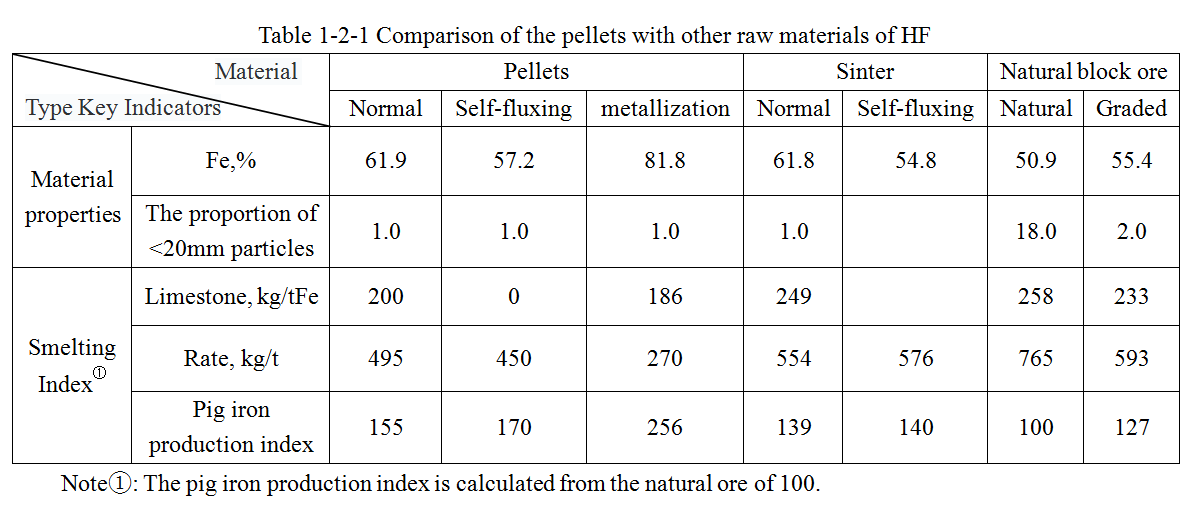
So far, about 850 billion tons of iron ore with the grade of more than 40% have been proven in the world. With the development of the iron and steel industry, the raw materials requirement of iron-making will become larger and larger, while the rich ore that can be used directly will be less and less. China has the fifth largest iron ore reserves in the world. But only about 4% of the proven reserves have the iron content of more than 50%, most of the others are poor minerals containing harmful impurities such as P, S, Pb, Zn, As.
Currently, 83~93% of the iron ore the proportion of iron ore in the United States and Europe is beneficiated, while in China, more than 95% must be beneficiated. Therefore, the ore agglomerates and the HF agglomerate rate are increasing year by year. Since the 1970s, the agglomerate rate of the key steel enterprises in China has reached 89%, which is equivalent to some developed countries. However, the natural block ore that directly feeds into BF is decreasing year by year, with less than 3 Mt currently, accounting for only 7% of the iron raw materials of BF. In a word, the change of iron ore resources and the superiority of ore agglomerates promoted the development of sintering and pelletizing technology.
Because of its good metallurgical properties, pellets have developed greatly since the 1960s. According to statistics, the annual pellets production capacity of some large steel enterprises in the world is over 285 Mt.
The smelting effect of pellets is obviously superior to other raw materials (as shown in the following table). It should be noted that the pelletizing and sintering have their respective application scope. And there is no competition between them, but a complementary relationship. The common purpose is agglomerating. In addition, the mixing of pellets and sinter is often unavoidable for BF.
The research work of iron concentrate pellets in China began in the early 1950s. It is proved by practice that it is necessary to develop pelletizing proportionally in order to meet the development needs of China's steel industry.

At present, China has the fifth largest iron ore reserves in the world, with the 57.6 billion tons of iron ore proved. But only about 2.53% of the proven reserves have the iron content of more than 40%. Therefore, more than 95% of the iron ore of China needs to be grinded and concentrated to meet the BF needs.
The pelletizing is one of the processes that can be processed the iron ore concentrate into the ore agglomerates with the physical properties, chemical composition and mineral structure to meet the requirements of BF. The processes are: batching and mixing the raw materials (such as iron ore concentrate, other powder material, additives, adhesives and so on) according to certain proportion; causing a series of physical and chemical changes to harden by drying, roasting, cooling and other technology. The process is process is called “pelletizing”, which is called “pelletizing method”, and its finished products are called “pellets”.
(1) The pellets, with high grade and less harmful elements, are the indispensable raw material for improving the BF materials according to “prepared burden guideline”. As is known to all, reasonable burden structure is the main means of high quality, low consumption, high yield and long life for BF. Based on the research and practice, the use of single sinter or pellets in BF cannot obtain the best production and economic indexes. The best burden structure of BF is high basicity sinter with addition of 20%~30% of acid pellets. As the “permeability enhancing agent”, the pellets improve the technical and economic indicators of BF, with the output increasing of 10% or so and energy-saving of 5% or so.
(2) It can make full use of the iron dust of steel enterprises and chemical enterprises, reuse the resources and reduce environmental pollution. A large amount of iron containing dust as by-product, such as BF gas dust, LD dust, sulfuric acid slag and so on, is produced in steel and chemical process. It has higher iron content, finer grain size and more harmful elements, which can't be fed directly into BF, but better to in balling. It can be reuse as BF burden by pelletizing to reduce the production costs and turn into profits.
(3) It is the main raw materials for the modern non-blast furnaces iron making. The non-blast furnace ironmaking has an important meaning to improve the energy structure, reduce the dependence of coke, shorten the steelmaking process, reduce the pollution of the environment and reduce the cost of steel making. The direct reduction sponge iron, which is high quality raw material of electric steelmaking, is of great significance to the development of short process of steelmaking. The melting reduction liquid iron is equivalent to BF iron.
The keys to energy saving of pelletizing are the using of advanced technology and process to improve the service life and operating rate of PSF. The history of pelletizing is much later than that of sinter, but new technology, equipment and technology for energy saving and emissions reducing are developed rapidly in recent years.
The total amount of SO2 produced in the steel industry is about 1.5 ~ 1.7 Mt/a, of which about 85% is from sintering process. According to the industrial standard of SO2 emission of less than 1.8kg/t.steel, China produced 568 MT of steel, and discharged at least 1.0224Mt of SO2 in 2009. Therefore, the desulfurization of sintering gas is a difficult urgent and task in China. In addition, the comprehensive treatment of dioxins, dust, nitrogen oxides, fluoride and so on, is the important task of environmental protection of steel industry.
The existing sintering machine in China mainly adopts“Ca-base method” desulfurization, accounted for more than 90%, including the “wet limestone - gypsum method”, “semi-dry method” and “dry method”, followed by "ammonia - ammonium sulfate method". Shao Steel adopts “MgO process”, while Tai Steel adopts “activated carbon absorption process” to desulfurization and denitration for 450m2 sinter and 600m2 sinter. These desulfurization processes have both advantages and disadvantages in the field of their own environmental protection, energy saving, low carbon emission, by-product reusing, low cost and reliable operation.
Scientific Treatment of Sintering Exhaust Gas According to the Practical Situation:
The sintering exhaust gas has the following characteristics: large volume with unstable changes; high oxygen content; low SO2 concentration with varies with the position; high dust containing heavy metal such as Pb, Cr, Zn and so on, corrosive gas such as HCl, HF, NOx, SOx and so on, and dioxins.
The sulfur resources are poor, while natural high-quality gypsum resources are rich in China. China, whose self-sufficiency rate is only about 10%, is the largest importer of sulfur in the world with the 1/3 of the world trade. In 2009, the sulfur imported was 12.37 Mt, of which more than 90% was used to produce sulfuric acid. And the sulphuric acid imported is 1.8-2.2Mt per year stably. The price of sulfuric acid was about 200-300 RMB/t in 2009, rising to 600-800 RMB/t in February 2010. Iron and steel enterprises also need sulphuric acid for ammonia removal of coke oven gas or other production. For example, A plant with steel output of 10 Mt/a needs about 44,000t of sulphuric annually. Therefore, it is meaningful to recover SO2 in the desulfurization process of sintering exhaust gas for economy development.
The Technical Characteristics of Sintering Gas Desulfurization with By-product of Sulfuric acid:
Based on the sintering process and the characteristics of its gas, The SML sintering exhaust gas desulfurization with by-product of sulfuric acid technology is developed and applied in engineering. It uses organic amine solution as absorbent to absorb SO2 and recycle for desorbing. It achieves the effect of the desulfurization efficiency of greater than 95%, the SO2 emission concentration of less than 100mg/Nm3, the dedusting efficiency of greater than 80%, and the denitration efficiency of greater than 60%.
SML desulfurization process consists of washing, absorption, desorption, adsorption liquid purification system and acid production process. The process is as follows: The exhaust gas is washed and cooled by washing tower, and enters the absorption tower after removing the dust and washing off most of the strong acid ions; The lean liquid, contacted with the washed gas, absorb SO2, and further the fine dust and the strong acid ions; The rich liquid after absorbing SO2 enters the heat exchanger and then enters the upper part of the desorption tower to desorption; The rich solution is heated in the desorption tower to extract the SO2, and the regenerated hot poor liquid is returned to the absorption tower for recycling. In this process, the chloride ions and ultra-fine dust are removed by liquid adsorption in chlorine removal device and filter device,part of the absorption liquid into the desalination device to remove thermal stability amine salt (strong acid radical ion). The SO2 desorbed out of the regenerator enters into the sulfuric acid process after cooling and separation. The acid-making adopts "single-conversion single-absorption" process. The SO2 gas and air enter into the drying tower together, and convert to sulfuric acid of greater than 98% after conversion and absorption sections in drying tower. The mixture of air and SO2 that has not been converted at the top of the tower returns to the flue before the washing tower to desulfurization circularly.